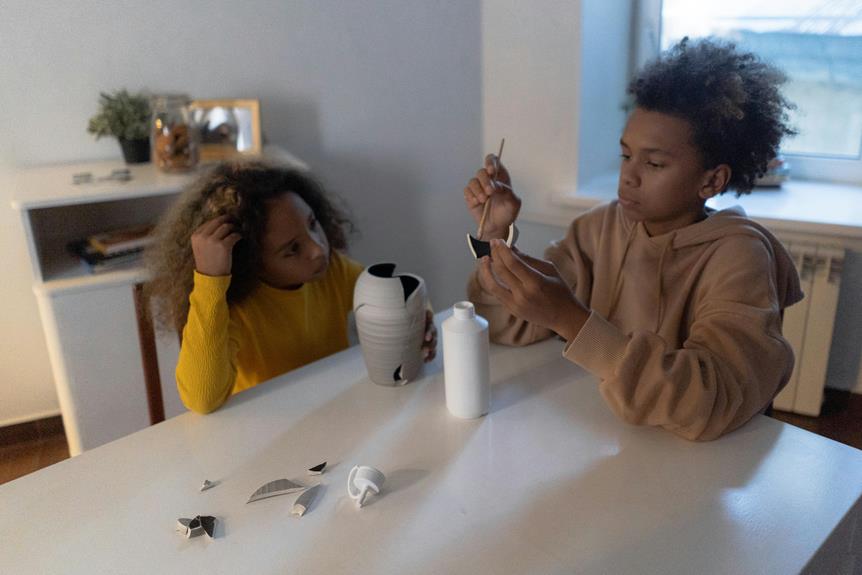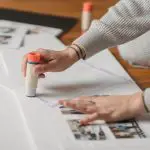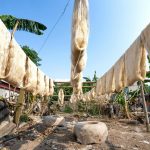When you use fabric glue, you might not realize there's a complex science at play behind its adhesion. It's not just about sticking two pieces of material together; it involves the intricate interaction of polymers and solvents that create lasting bonds. As the glue dries, these components work together to ensure a strong hold, influenced by factors like fabric type and environmental conditions. Understanding these elements can significantly affect your crafting projects, but what exactly do those interactions look like in practice? Let's explore that further.
Table of Contents
Key Takeaways
- Fabric glue creates strong bonds through polymers and solvents, allowing for flexible adhesion without sewing.
- Adhesion occurs via mechanical bonding and chemical bonds, including covalent and ionic connections.
- Surface texture and fabric type significantly influence bond strength, with natural fibers typically providing better absorption.
- Environmental factors like temperature and humidity affect glue viscosity, drying time, and overall bond integrity.
What Is Fabric Glue?
Fabric glue is a versatile adhesive specifically designed to bond fabrics together without the need for sewing. This means you can tackle various projects, from quick repairs to intricate crafts, with ease. It's perfect for those who want to avoid the hassle of threading a needle or dealing with a sewing machine.
You'll find fabric glue comes in several forms, including liquid, gel, and stick formats, catering to different applications. Each type has its unique advantages—liquid glue might be better for larger areas, while gel glue offers precision for small details. Most fabric glues dry clear, ensuring a neat finish on your projects.
When you use fabric glue, you'll appreciate its flexibility. It remains somewhat pliable even after drying, allowing the fabric to move without cracking or breaking the bond. This characteristic makes it ideal for items that experience regular wear and tear, like clothing or upholstery.
In addition, fabric glue is generally washable, making it a reliable choice for long-lasting repairs. Whether you're fixing a hem or creating a fabric collage, fabric glue makes your crafting experience simple and enjoyable.
How Fabric Glue Works
Understanding how fabric glue works involves knowing that it uses a combination of polymers and solvents to create a strong bond between materials. When you apply fabric glue, the solvent evaporates, allowing the polymers to intertwine with the fibers of the fabrics you're working with. This interaction forms a solid bond as the glue dries, which is critical for ensuring your materials stay securely attached.
The polymers in the glue are specifically designed to be flexible and durable, accommodating the natural movement of fabric. This flexibility is essential, especially in items like clothing or home textiles, where bending and stretching occur. When you press the fabrics together, the glue fills in the gaps between the fibers, enhancing the adhesion.
You'll also notice that different fabric glues have varying drying times and strengths. Some are formulated for quick-drying applications, while others offer a more robust hold for heavy-duty projects. By understanding these properties, you can choose the right fabric glue for your specific needs and ensure a successful bond in your crafting or repair projects.
Types of Adhesive Bonds
When you choose fabric glue, understanding the types of adhesive bonds is crucial for achieving the best results.
Mechanical bonding, chemical properties, and environmental factors all play significant roles in how well your adhesive holds up.
Let's explore each of these points to help you make informed decisions.
Mechanical Bonding Explained
Exploring the different types of adhesive bonds reveals how mechanical bonding enhances the strength and durability of your fabric projects.
Mechanical bonding occurs when the adhesive penetrates the surface of the materials, creating a physical interlock that holds them together. This type of bond is particularly effective for fabric projects where flexibility and movement are essential.
When you're working with fabric glue, keep in mind a few key aspects of mechanical bonding:
- Surface texture: The rougher the surface, the better the mechanical bond. Textured fabrics allow the adhesive to grip more effectively.
- Application method: Applying the glue evenly ensures the adhesive penetrates deeply into the fabric's fibers, maximizing the bond.
Chemical Adhesive Properties
While mechanical bonding is important, chemical adhesive properties also play a significant role in creating strong and lasting connections between fabrics. Understanding these properties helps you choose the right fabric glue for your projects.
There are two main types of adhesive bonds: covalent and ionic. Covalent bonds form when atoms share electrons, creating a strong, stable connection. This type of bond is typically found in high-performance adhesives, providing excellent durability and resistance to environmental factors. When you use a fabric glue with covalent bonds, you can expect a long-lasting hold.
Ionic bonds, on the other hand, occur when atoms transfer electrons, leading to a weaker connection compared to covalent bonds. These types of adhesives may work well for temporary fixes or lightweight fabrics. If you need a quick, easy solution, this option might be ideal for you.
In addition to these bonds, the chemical makeup of the adhesive can affect its performance. Some adhesives contain polymers, which enhance flexibility and strength. By understanding these chemical adhesive properties, you can make informed choices that enhance your fabric projects.
Environmental Factors Impacting Adhesion
Understanding how environmental factors impact adhesion can significantly affect the performance of your fabric glue, ensuring better results for your projects. Various conditions can influence how well your adhesive bonds with the fabric, and being aware of these can help you achieve optimal results.
Consider these key environmental factors:
- Temperature: High or low temperatures can alter the viscosity of the glue, affecting how well it penetrates the fabric fibers. Ideally, you should apply fabric glue in a moderate temperature range for the best adhesion.
- Humidity: Excess moisture in the air can interfere with the drying process, leading to weak bonds. Always check the humidity levels before starting your project, as ideal conditions are generally dry.
Chemical Composition of Fabric Glue
Fabric glue typically contains a blend of polymers, solvents, and additives that work together to create a strong, flexible bond between fabrics. Understanding the chemical composition can help you choose the right glue for your project.
Here's a quick overview of the key components:
| Component | Function | Example |
|---|---|---|
| Polymers | Provide adhesion and flexibility | PVA (Polyvinyl Acetate) |
| Solvents | Enable application and drying | Water or Acetone |
| Additives | Enhance properties like durability | Plasticizers |
Polymers form the backbone of the glue, allowing it to maintain flexibility after drying. Solvents help the glue spread evenly on the fabric surfaces, ensuring maximum contact for adhesion. Once the solvent evaporates, the polymers bond the materials together. Additives can modify the glue's characteristics, making it more resistant to heat or moisture.
Factors Affecting Adhesion
Several factors influence the adhesion of fabric glue, including surface texture, fabric type, and environmental conditions. When you're working with fabric glue, understanding these elements can significantly impact your project's success.
Surface Texture: Smooth surfaces tend to allow for better adhesion compared to rougher ones. If the fabric's texture is uneven, the glue may not bond effectively.
Fabric Type: Different fabrics have varying properties. Natural fibers like cotton often absorb glue better than synthetic materials like polyester, which can repel adhesives.
Environmental Conditions: Temperature and humidity play a crucial role in adhesion. High humidity can weaken the bond, while extreme temperatures might cause the glue to dry too quickly or not at all.
Testing Adhesive Strength
When you're testing adhesive strength, it's crucial to understand the different types of adhesive tests available.
Each test can reveal various factors that affect the overall strength of your fabric glue.
Let's explore these methods and their significance in ensuring your projects hold up.
Types of Adhesive Tests
Understanding the various types of adhesive tests is crucial for determining how well different fabric glues perform under stress. Each test measures adhesive strength in unique ways, providing you with valuable insights.
Here are some common adhesive tests you might encounter:
- Peel Test: This test evaluates how well the glue resists being pulled apart at the bond line. You'll apply a force to separate the bonded materials, observing how much force is needed to break the bond.
- Shear Test: In this test, you'll apply a load parallel to the adhesive bond. It helps you understand the glue's ability to withstand forces trying to slide the materials apart.
Factors Affecting Strength
Various factors can influence the strength of fabric glue, impacting its performance in different applications. One of the most significant factors is the type of fabric you're using. Some materials, like cotton, bond more effectively than slippery fabrics like nylon or polyester. You should also consider the surface texture; smooth surfaces mightn't hold as well compared to rougher ones.
Temperature plays a crucial role too. If you apply the glue in a cold environment, it may not cure properly, weakening the bond. Similarly, humidity can affect drying times and overall strength. Make sure to work in a controlled environment for the best results.
Additionally, the amount of adhesive applied can influence strength. Too little won't create a solid bond, while too much might lead to excess seepage, weakening the connection. Also, remember to follow the manufacturer's instructions on curing time—rushing this process can compromise the adhesive's effectiveness.
Lastly, testing the bond strength through methods like peel tests can provide insights into how well your fabric glue performs in real-world situations. Understanding these factors will help ensure you achieve strong, lasting adhesion in your projects.
Applications in Crafting
Fabric glue is a versatile tool in crafting that allows you to bond materials quickly and securely without the need for sewing.
Whether you're a beginner or experienced crafter, fabric glue opens up a world of creative possibilities. You can use it for a variety of projects, enabling you to focus on your creativity rather than the hassle of traditional methods.
Here are some popular applications of fabric glue in crafting:
- Home Decor: Create personalized cushions, wall hangings, or decorative fabric art to add a touch of your style to your space.
- Costumes and Accessories: Secure embellishments, patches, or fabric layers to costumes and accessories, making your designs stand out.
Using fabric glue can simplify your crafting process, allowing you to experiment with different fabrics and textures.
You'll appreciate the instant bond and flexibility it offers, making it an essential addition to your crafting toolkit. So, grab your fabric glue and let your imagination run wild!
Frequently Asked Questions
Can Fabric Glue Be Used on Non-Fabric Materials?
Yes, you can use fabric glue on non-fabric materials, but it might not bond as effectively. Always check the manufacturer's instructions to ensure compatibility with the surfaces you're working with for the best results.
How Long Does Fabric Glue Take to Dry Completely?
Fabric glue typically takes about 24 hours to dry completely, but it can vary based on factors like humidity and thickness of application. Always check the manufacturer's instructions for specific drying times to ensure the best results.
Is Fabric Glue Washable After Bonding?
Yes, fabric glue is generally washable after bonding, but it depends on the specific product. Always check the manufacturer's instructions to ensure it's water-resistant and suitable for your fabric before washing.
Can Fabric Glue Be Removed From Fabric?
Yes, you can remove fabric glue from fabric, but it depends on the type and how long it's been set. Try using rubbing alcohol or a fabric adhesive remover for the best results. Always test first!
What Is the Shelf Life of Fabric Glue?
The shelf life of fabric glue usually ranges from one to three years, depending on the brand and storage conditions. Always check the label for specific details, and store it in a cool, dry place.
- The History and Evolution of Chamois Fabric - June 22, 2025
- Chamois Fabric on Wikipedia: What You Need to Know - June 22, 2025
- How to Pronounce Chamois Fabric Correctly - June 22, 2025







